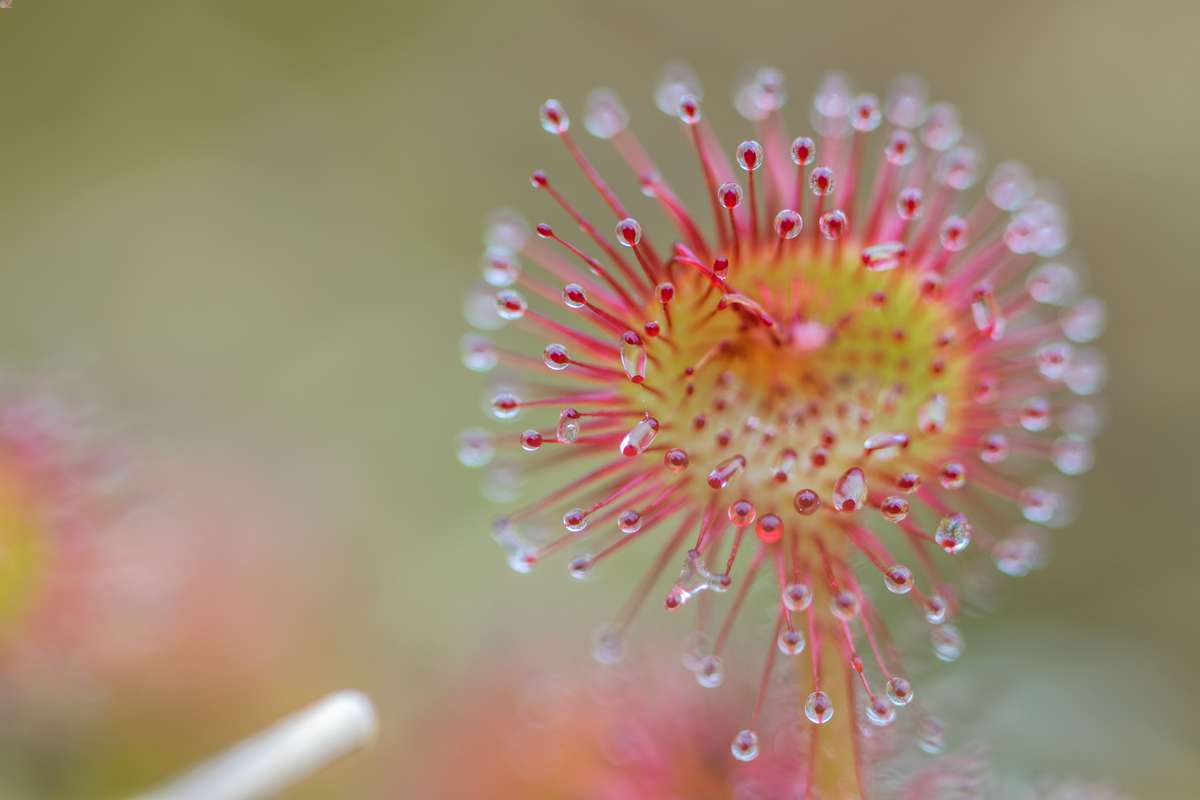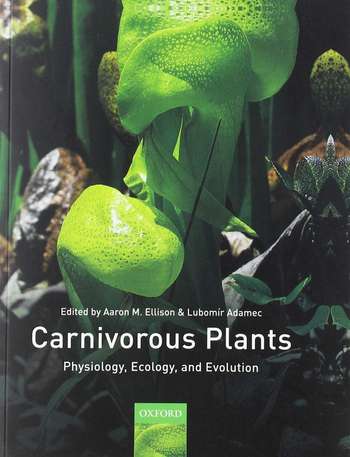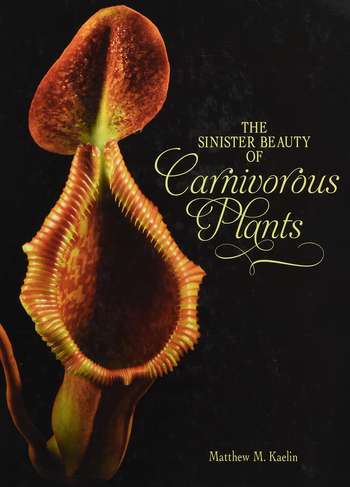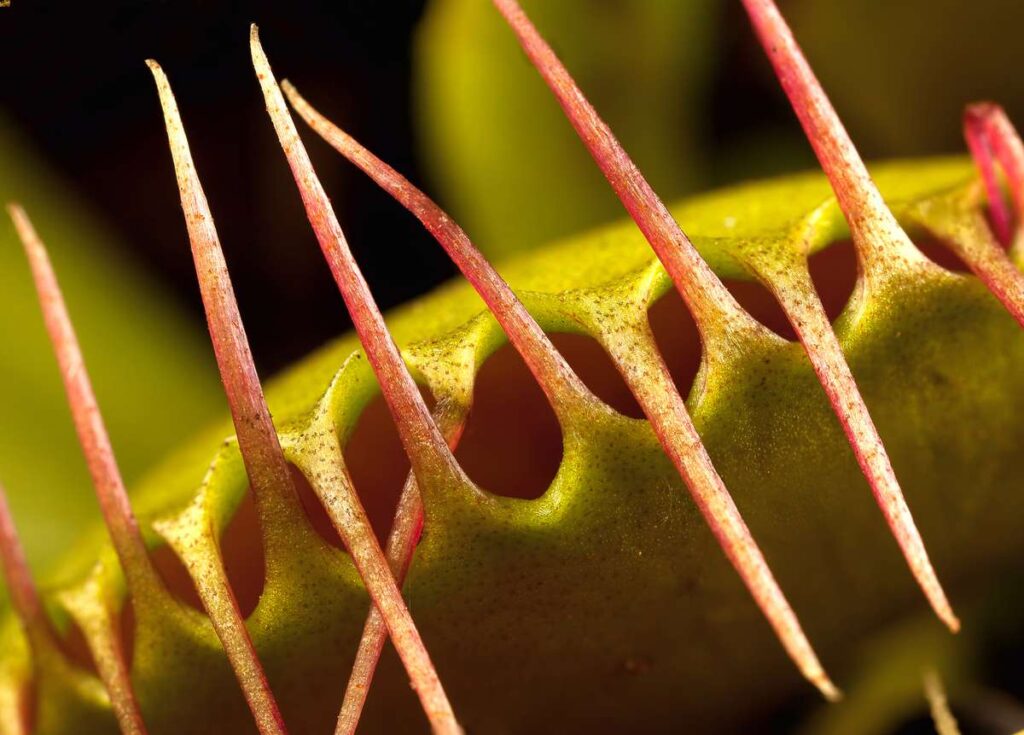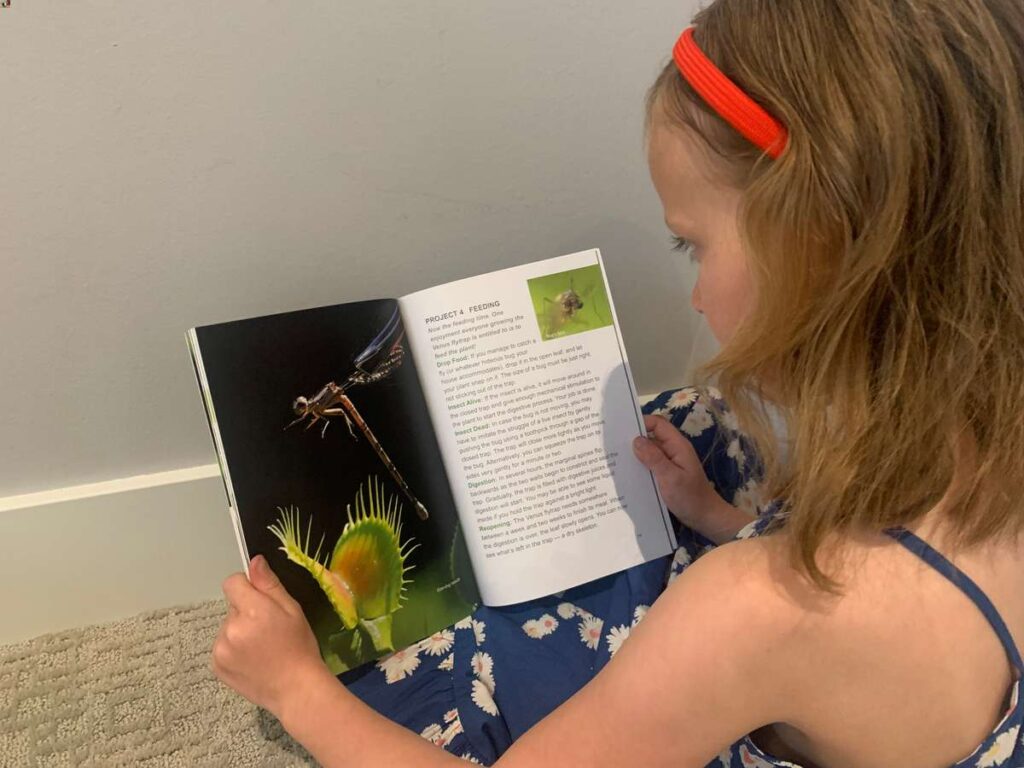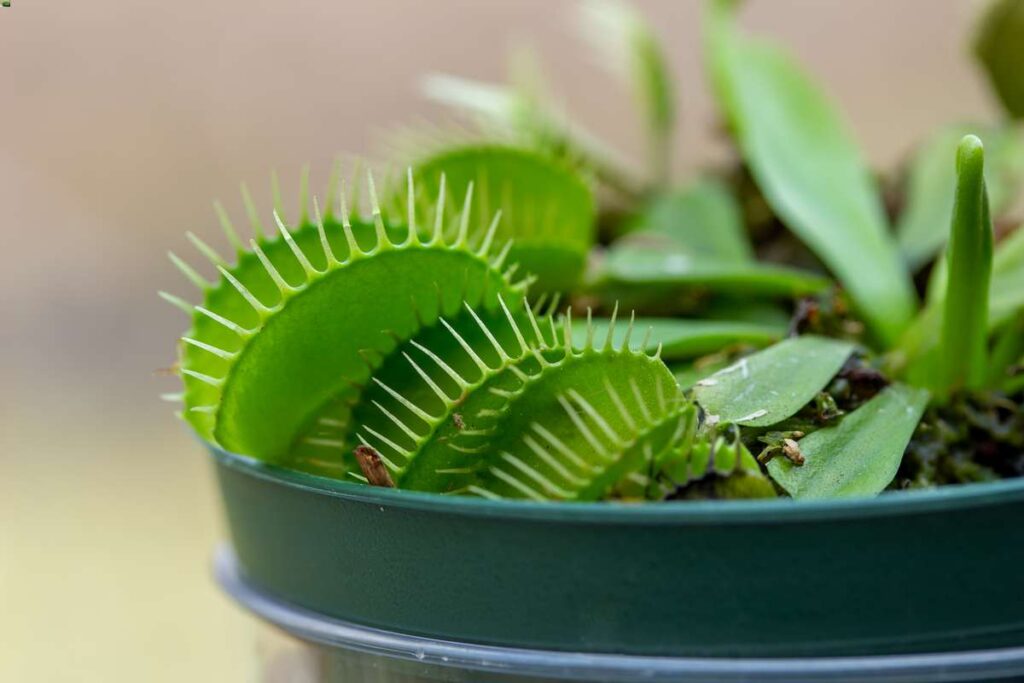Welcome carnivorous plant fans! This free, illustrated version of Chapter 4 of Insectivorous Plants by Charles Darwin has been lightly edited to be more internet friendly. The main text of Chapter 4 of Insectivorous Plants is presented here in its entirety; we have simply removed some of the table of contents material, created more white space for easier reading, added a color picture or two, etc.
We hope you enjoy this free, online version of the Charles Darwin book Insectivorous Plants, Chapter 4.
This post contains compensated links.
CHAPTER IV
THE EFFECTS OF HEAT ON THE LEAVES
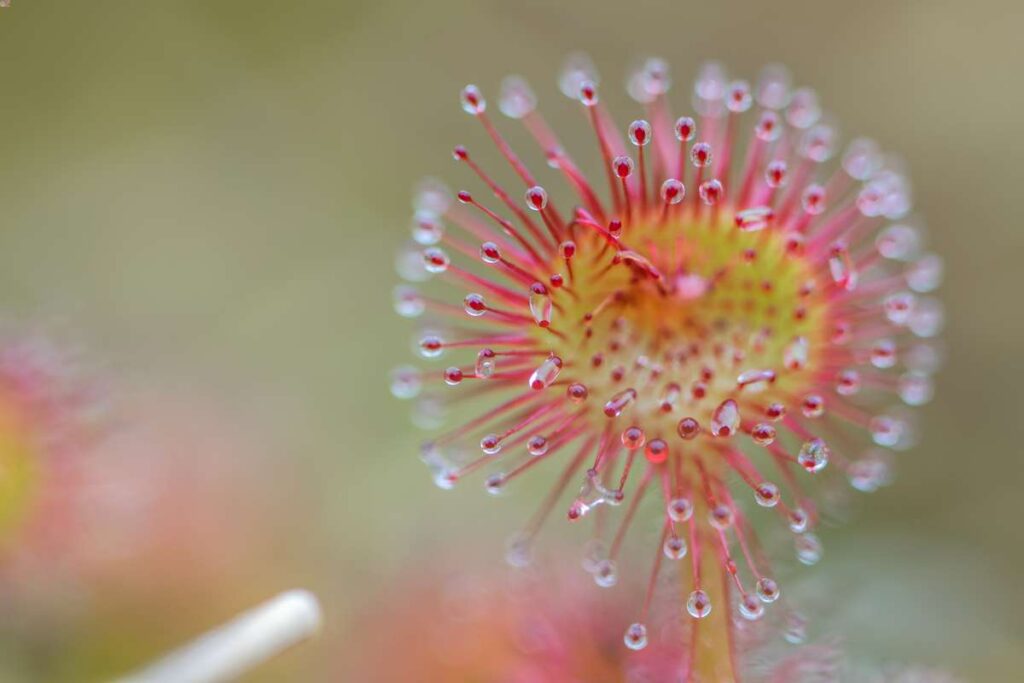
Insectivorous Plants – Chapter 4 Topics:
- Nature of the experiments
- Effects of boiling water
- Warm water causes rapid inflection
- Water at a higher temperature does not cause immediate inflection, but does not kill the leaves, as shown by their subsequent re-expansion and by the aggregation of the protoplasm
- A still higher temperature kills the leaves and coagulates the albuminous contents of the glands.
IN my observations on Drosera rotundifolia, the leaves seemed to be more quickly inflected over animal substances, and to remain inflected for a longer period during very warm than during cold weather. I wished, therefore, to ascertain whether heat alone would induce inflection, and what temperature was the most efficient.
Another interesting point presented itself, namely, at what degree life was extinguished; for Drosera offers unusual facilities in this respect, not in the loss of the power of inflection, but in that of subsequent re-expansion, and more especially in the failure of the protoplasm to become aggregated, when the leaves after being heated are immersed in a solution of carbonate of ammonia.*
* When my experiments on the effects of heat were made, I was not aware that the subject had been carefully investigated by several observers. For instance, Sachs is convinced (‘Trait de Botanique,’ 1874, pp. 772, 854) that the most different kinds of plants all perish if kept for 10 m. in water at 45° to 46° Cent., or 113° to 115° Fahr.; and he concludes that the protoplasm within their cells always coagulates, if in a damp condition, at a temperature of between 50° and 60° Cent., or 122° to 140° Fahr. Max Schultze and Khne (as quoted by Dr. Bastian in ‘Contemp. Review,’ 1874, p. 528) “found that the protoplasm of plant-cells, with which they experimented, was always killed and altered by a very brief exposure to a temperature of 118 1/2° Fahr. as a maximum.” As my results are deduced from special phenomena, namely, the subsequent aggregation of the protoplasm and the re-expansion of the tentacles, they seem to me worth giving. We shall find that Drosera resists heat somewhat better than most other plants. That there should be considerable differences in this respect is not surprising, considering that some low vegetable organisms grow in hot springs—cases of which have been collected by Prof. Wyman (‘American Journal of Science,’ vol. xliv. 1867). Thus, Dr. Hooker found Confervae in water at 168° Fahr.; Humboldt, at 185° Fahr.; and Descloizeaux, at 208° Fahr.)
My experiments were tried in the following manner. Leaves were cut off, and this does not in the least interfere with their powers; for instance, three cut off leaves, with bits of meat placed on them, were kept in a damp atmosphere, and after 23 hrs. closely embraced the meat both with their tentacles and blades; and the protoplasm within their cells was well aggregated.
Three ounces of doubly distilled water was heated in a porcelain vessel, with a delicate thermometer having a long bulb obliquely suspended in it. The water was gradually raised to the required temperature by a spirit-lamp moved about under the vessel; and in all cases the leaves were continually waved for some minutes close to the bulb.
They were then placed in cold water, or in a solution of carbonate of ammonia. In other cases they were left in the water, which had been raised to a certain temperature, until it cooled. Again in other cases the leaves were suddenly plunged into water of a certain temperature, and kept there for a specified time.
Considering that the tentacles are extremely delicate, and that their coats are very thin, it seems scarcely possible that the fluid contents of their cells should not have been heated to within a degree or two of the temperature of the surrounding water. Any further precautions would, I think, have been superfluous, as the leaves from age or constitutional causes differ slightly in their sensitiveness to heat.
It will be convenient first briefly to describe the effects of immersion for thirty seconds in boiling water. The leaves are rendered flaccid, with their tentacles bowed backwards, which, as we shall see in a future chapter, is probably due to their outer surfaces retaining their elasticity for a longer period than their inner surfaces retain the power of contraction.
The purple fluid within the cells of the pedicels is rendered finely granular, but there is no true aggregation; nor does this follow when the leaves are subsequently placed in a solution of carbonate of ammonia. But the most remarkable change is that the glands become opaque and uniformly white; and this may be attributed to the coagulation of their albuminous contents.
My first and preliminary experiment consisted in putting seven leaves in the same vessel of water, and warming it slowly up to the temperature of 110° Fahr. (43.3° Cent.); a leaf being taken out as soon as the temperature rose to 80° (26.6° Cent.), another at 85°, another at 90°, and so on.
Each leaf, when taken out, was placed in water at the temperature of my room, and the tentacles of all soon became slightly, though irregularly, inflected. They were now removed from the cold water and kept in damp air, with bits of meat placed on their discs.
The leaf which had been exposed to the temperature of 110° became in 15 m. greatly inflected; and in 2 hrs. every single tentacle closely embraced the meat. So it was, but after rather longer intervals, with the six other leaves. It appears, therefore, that the warm bath had increased their sensitiveness when excited by meat.
I next observed the degree of inflection which leaves underwent within stated periods, whilst still immersed in warm water, kept as nearly as possible at the same temperature; but I will here and elsewhere give only a few of the many trials made.
A leaf was left for 10 m. in water at 100° (37.7° Cent.), but no inflection occurred. A second leaf, however, treated in the same manner, had a few of its exterior tentacles very slightly inflected in 6 m., and several irregularly but not closely inflected in 10 m. A third leaf, kept in water at 105° to 106° (40.5° to 41.1° Cent.), was very moderately inflected in 6 m. A fourth leaf, in water at 110° (43.3° Cent.), was somewhat inflected in 4 m., and considerably so in from 6 to 7 m.
Three leaves were placed in water which was heated rather quickly, and by the time the temperature rose to 115°-116° (46.1° to 46.06° Cent.), all three were inflected. I then removed the lamp, and in a few minutes every single tentacle was closely inflected. The protoplasm within the cells was not killed, for it was seen to be in distinct movement; and the leaves, having been left in cold water for 20 hrs., re-expanded.
Another leaf was immersed in water at 100° (37.7° Cent.), which was raised to 120° (48.8° Cent.); and all the tentacles, except the extreme marginal ones, soon became closely inflected. The leaf was now placed in cold water, and in 7 hrs. 30 m. it had partly, and in 10 hrs. fully, re-expanded.
On the following morning it was immersed in a weak solution of carbonate of ammonia, and the glands quickly became black, with strongly marked aggregation in the tentacles, showing that the protoplasm was alive, and that the glands had not lost their power of absorption. Another leaf was placed in water at 110° (43.3° Cent.) which was raised to 120° (48.8° Cent.); and every tentacle, excepting one, was quickly and closely inflected.
This leaf was now immersed in a few drops of a strong solution of carbonate of ammonia (one part to 109 of water); in 10 m. all the glands became intensely black, and in 2 hrs. the protoplasm in the cells of the pedicels was well aggregated. Another leaf was suddenly plunged, and as usual waved about, in water at 120°, and the tentacles became inflected in from 2 m. to 3 m., but only so as to stand at right angles to the disc.
The leaf was now placed in the same solution (viz. one part of carbonate of ammonia to 109 of water, or 4 grs. to 1 oz., which I will for the future designate as the strong solution), and when I looked at it again after the interval of an hour, the glands were blackened, and there was well-marked aggregation.
After an additional interval of 4 hrs. the tentacles had become much more inflected. It deserves notice that a solution as strong as this never causes inflection in ordinary cases. Lastly a leaf was suddenly placed in water at 125° (51.6° Cent.), and was left in it until the water cooled; the tentacles were rendered of a bright red and soon became inflected.
The contents of the cells underwent some degree of aggregation, which in the course of three hours increased; but the masses of protoplasm did not become spherical, as almost always occurs with leaves immersed in a solution of carbonate of ammonia.
We learn from these cases that a temperature of from 120° to 125° (48.8° to 51.6° Cent.) excites the tentacles into quick movement, but does not kill the leaves, as shown either by their subsequent re-expansion or by the aggregation of the protoplasm. We shall now see that a temperature of 130° (54.4° Cent.) is too high to cause immediate inflection, yet does not kill the leaves.
Experiment 1
A leaf was plunged, and as in all cases waved about for a few minutes, in water at 130° (54.4° Cent.), but there was no trace of inflection; it was then placed in cold water, and after an interval of 15 m. very slow movement was distinctly seen in a small mass of protoplasm in one of the cells of a tentacle.* After a few hours all the tentacles and the blade became inflected.
* Sachs states (‘Trait de Botanique,’ 1874, p. 855) that the movements of the protoplasm in the hairs of a Cucurbita ceased after they were exposed for 1 m. in water to a temperature of 47° to 48° Cent., or 117° to 119° Fahr.
Experiment 2
Another leaf was plunged into water at 130° to 131°, and as before there was no inflection. After being kept in cold water for an hour, it was placed in the strong solution of ammonia, and in the course of 55 m. the tentacles were considerably inflected. The glands, which before had been rendered of a brighter red, were now blackened. The protoplasm in the cells of the tentacles was distinctly aggregated; but the spheres were much smaller than those generated in unheated leaves when subjected to carbonate of ammonia. After an additional 2 hrs. all the tentacles, excepting six or seven, were closely inflected.
Experiment 3
A similar experiment to the last, with exactly the same results.
Experiment 4
A fine leaf was placed in water at 100° (37.7° Cent.), which was then raised to 145° (62.7° Cent.). Soon after immersion, there was, as might have been expected, strong inflection. The leaf was now removed and left in cold water; but from having been exposed to so high a temperature, it never re-expanded.
Experiment 5
Leaf immersed at 130° (54.4° Cent.), and the water raised to 145° (62.7° Cent.), there was no immediate inflection; it was then placed in cold water, and after 1 hr. 20 m. some of the tentacles on one side became inflected. This leaf was now placed in the strong solution, and in 40 m. all the submarginal tentacles were well inflected, and the glands blackened.
After an additional interval of 2 hrs. 45 m. all the tentacles, except eight or ten, were closely inflected, with their cells exhibiting a slight degree of aggregation; but the spheres of protoplasm were very small, and the cells of the exterior tentacles contained some pulpy or disintegrated brownish matter.
Experiments 6 and 7
Two leaves were plunged in water at 135° (57.2° Cent.) which was raised to 145° (62.7° Cent.); neither became inflected. One of these, however, after having been left for 31 m. in cold water, exhibited some slight inflection, which increased after an additional interval of 1 hr. 45 m., until all the tentacles, except sixteen or seventeen, were more or less inflected; but the leaf was so much injured that it never re-expanded.
The other leaf, after having been left for half an hour in cold water, was put into the strong solution, but no inflection ensued; the glands, however, were blackened, and in some cells there was a little aggregation, the spheres of protoplasm being extremely small; in other cells, especially in the exterior tentacles, there was much greenish-brown pulpy matter.
Experiment 8
A leaf was plunged and waved about for a few minutes in water at 140° (60° Cent.), and was then left for half an hour in cold water, but there was no inflection. It was now placed in the strong solution, and after 2 hrs. 30 m. the inner submarginal tentacles were well inflected, with their glands blackened, and some imperfect aggregation in the cells of the pedicels.
Three or four of the glands were spotted with the white porcelain-like structure, like that produced by boiling water. I have seen this result in no other instance after an immersion of only a few minutes in water at so low a temperature as 140°, and in only one leaf out of four, after a similar immersion at a temperature of 145° Fahr.
On the other hand, with two leaves, one placed in water at 145° (62.7° Cent.), and the other in water at 140° (60° Cent.), both being left therein until the water cooled, the glands of both became white and porcelain-like. So that the duration of the immersion is an important element in the result.
Experiment 9
A leaf was placed in water at 140° (60° Cent.), which was raised to 150° (65.5° Cent.); there was no inflection; on the contrary, the outer tentacles were somewhat bowed backwards. The glands became like porcelain, but some of them were a little mottled with purple. The bases of the glands were often more affected than their summits. This leaf having been left in the strong solution did not undergo any inflection or aggregation.
Experiment 10
A leaf was plunged in water at 150° to 150 1/2° (65.5° Cent.); it became somewhat flaccid, with the outer tentacles slightly reflexed, and the inner ones a little bent inwards, but only towards their tips; and this latter fact shows that the movement was not one of true inflection, as the basal part alone normally bends.
The tentacles were as usual rendered of a very bright red, with the glands almost white like porcelain, yet tinged with pink. The leaf having been placed in the strong solution, the cell-contents of the tentacles became of a muddy-brown, with no trace of aggregation.
Experiment 11
A leaf was immersed in water at 145° (62.7° Cent.), which was raised to 156° (68.8° Cent.). The tentacles became bright red and somewhat reflexed, with almost all the glands like porcelain; those on the disc being still pinkish, those near the margin quite white. The leaf being placed as usual first in cold water and then in the strong solution, the cells in the tentacles became of a muddy greenish brown, with the protoplasm not aggregated.
Nevertheless, four of the glands escaped being rendered like porcelain, and the pedicels of these glands were spirally curled, like a French horn, towards their upper ends; but this can by no means be considered as a case of true inflection. The protoplasm within the cells of the twisted portions was aggregated into distinct though excessively minute purple spheres.
This case shows clearly that the protoplasm, after having been exposed to a high temperature for a few minutes, is capable of aggregation when afterwards subjected to the action of carbonate of ammonia, unless the heat has been sufficient to cause coagulation.
Concluding Remarks
As the hair-like tentacles are extremely thin and have delicate walls, and as the leaves were waved about for some minutes close to the bulb of the thermometer, it seems scarcely possible that they should not have been raised very nearly to the temperature which the instrument indicated.
From the eleven last observations we see that a temperature of 130° (54.4° Cent.) never causes the immediate inflection of the tentacles, though a temperature from 120° to 125° (48.8° to 51.6° Cent.) quickly produces this effect. But the leaves are paralysed only for a time by a temperature of 130°, as afterwards, whether left in simple water or in a solution of carbonate of ammonia, they become inflected and their protoplasm undergoes aggregation.
This great difference in the effects of a higher and lower temperature may be compared with that from immersion in strong and weak solutions of the salts of ammonia; for the former do not excite movement, whereas the latter act energetically. A temporary suspension of the power of movement due to heat is called by Sachs* heat-rigidity; and this in the case of the sensitive-plant (Mimosa) is induced by its exposure for a few minutes to humid air, raised to 120°-122° Fahr., or 49° to 50° Cent.
* ‘Trait de Bot.’ 1874, p. 1034.
It deserves notice that the leaves of Drosera, after being immersed in water at 130° Fahr., are excited into movement by a solution of the carbonate so strong that it would paralyse ordinary leaves and cause no inflection.
The exposure of the leaves for a few minutes even to a temperature of 145° Fahr. (62.7° Cent.) does not always kill them; as when afterwards left in cold water, or in a strong solution of carbonate of ammonia, they generally, though not always, become inflected; and the protoplasm within their cells undergoes aggregation, though the spheres thus formed are extremely small, with many of the cells partly filled with brownish muddy matter.
In two instances, when leaves were immersed in water, at a lower temperature than 130° (54.4° Cent.), which was then raised to 145° (62.7° Cent.), they became during the earlier period of immersion inflected, but on being afterwards left in cold water were incapable of re-expansion. Exposure for a few minutes to a temperature of 145° sometimes causes some few of the more sensitive glands to be speckled with the porcelain-like appearance; and on one occasion this occurred at a temperature of 140° (60° Cent.).
On another occasion, when a leaf was placed in water at this temperature of only 140°, and left therein till the water cooled, every gland became like porcelain. Exposure for a few minutes to a temperature of 150° (65.5° Cent.) generally produces this effect, yet many glands retain a pinkish colour, and many present a speckled appearance. This high temperature never causes true inflection; on the contrary, the tentacles commonly become reflexed, though to a less degree than when immersed in boiling water; and this apparently is due to their passive power of elasticity.
After exposure to a temperature of 150° Fahr., the protoplasm, if subsequently subjected to carbonate of ammonia, instead of undergoing aggregation, is converted into disintegrated or pulpy discoloured matter. In short, the leaves are generally killed by this degree of heat; but owing to differences of age or constitution, they vary somewhat in this respect. In one anomalous case, four out of the many glands on a leaf, which had been immersed in water raised to 156° (68.8° Cent.), escaped being rendered porcellanous;* and the protoplasm in the cells close beneath these glands underwent some slight, though imperfect, degree of aggregation.
* As the opacity and porcelain-like appearance of the glands is probably due to the coagulation of the albumen, I may add, on the authority of Dr. Burdon Sanderson, that albumen coagulates at about 155°, but, in presence of acids, the temperature of coagulation is lower. The leaves of Drosera contain an acid, and perhaps a difference in the amount contained may account for the slight differences in the results above recorded.
Finally, it is a remarkable fact that the leaves of Drosera rotundifolia, which flourishes on bleak upland moors throughout Great Britain, and exists (Hooker) within the Arctic Circle, should be able to withstand for even a short time immersion in water heated to a temperature of 145°. *
* It appears that cold-blooded animals are, as might have been expected, far more sensitive to an increase of temperature than is Drosera. Thus, as I hear from Dr. Burdon Sanderson, a frog begins to be distressed in water at a temperature of only 85° Fahr. At 95° the muscles become rigid, and the animal dies in a stiffened condition.
It may be worth adding that immersion in cold water does not cause any inflection: I suddenly placed four leaves, taken from plants which had been kept for several days at a high temperature, generally about 75° Fahr. (23.8° Cent.), in water at 45° (7.2° Cent.), but they were hardly at all affected; not so much as some other leaves from the same plants, which were at the same time immersed in water at 75°; for these became in a slight degree inflected.
More Chapters from Insectivorous Plants by Charles Darwin
Insectivorous Plants Table of Contents
Previous – Chapter 3: Aggregation of the Protoplasm Within the Cells of the Tentacles
Up next – Chapter 5: The Effects of Non-Nitrogenous and Nitrogenous Organic Fluids on the Leaves

